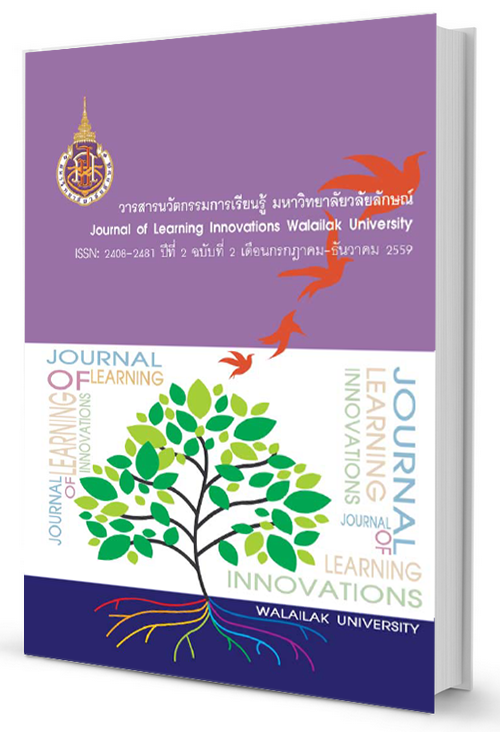Experiences Regarding Dengue Disease in High School Education Level of Health Science Student Starting Admission in the University
DOI:
https://doi.org/10.14456/jli.2016.11Keywords:
ประสบการณ์เกี่ยวกับโรคไข้เลือดออก, ความรู้เรื่องโรคไข้เลือดออกระดับมัธยมศึกษา, ความตระหนักของนักศึกษาสาขาวิทยาศาสตร์สุขภาพเรื่องโรคไข้เลือดออก, Experiences of dengue disease, High school level knowledge of dengue, Health science students’ awareness of denAbstract
The objective of the study was to describe dengue’s experiences in high school level of health science students at a university. The study employed phenomenology design with qualitative data collection. Participants were from four institutes including Nursing, medicine, Pharmacology, and Allied health Science and Public Health, selected with purposive sampling from their first classes at university. Observations and five focus groups discussions followed the question guidelines such as dengue experiences, prevention, self-care, and environment management. Data analysis used thematic analysis techniques, and trustworthiness with group member check and literature review.
Results of the study explained dengue experiences based on four main themes and 16 sub-themes: 1) “Study about dengue at the level of high school course from several sources, but it’s not enough” consisting of three sub-themes, 2) “Severities of dengue disease may result in death should be prevented although it does not happen to me”, consisting of two sub-themes, 3) “Must be especially careful about dengue with appropriate techniques to the varying contexts contexts, consisting of two sub-themes, and 4) “Collaborative efforts with multiple methods the university safety from larval indices, mosquito, and dengue” consisting of two sub-themes. In conclusion, students’ experiences with dengue help all stakeholders improve their understanding and the information used as a foundation for an education program, awareness empowerment, and promotion of students’ dengue prevention behavior at the university.
References
จรวย สุวรรณบำรุง, จันทร์จุรีย์ ถือทอง และ ธิดารัตน์ เอกคิรินิมิตร. (2558). การมีส่วนร่วมของนักศึกษาในกิจกรรมเฝืาระวังดัชนีลูกนํ้ายุงลายในมหาวิทยาลัย วลัยลักษณ์: ต้นแบบการเฝืาระวังเซิงรุกในการป้องกันโรคไข้เลือดออกของพื้นที่ สถานศึกษา. วารสารการพัฒนาชุมชนและคุณภาพชีวิต, 3(1), 81-93.
คิริพร จิรวัฒน์กุล. (2553). การวิจัยเชิงคุณภาพต้านวิทยาศาสตร์สุขภาพ. กรุงเทพฯ: ออพิเช็ด ครีเอชั่น.
คิริเพ็ญ กัลยาณรุจ, มุกดา หวังวีรวงศ์ และ วารุณี วัชรเสวี. (2556). การวินิจฉัยและ รักษาโรคไข้เลือดออก เดงกี ฉบับเฉลิมพระเกียรติ 80 พรรษามหาราชิปี. กรุงเทพฯ: สำนักโรคติดต่อนำดดยแมลง กรมควบคุมโรค กระทรวงสาธารณสุข.
ศุขธิดา อุบล และ จันฑพงษ์ วสี. (2549). ไข้เลือดออกเดงกี ไวรัสวิทยา พยาริกำเนิด จากกลไกภูมิคุ้มกัน การวินิจฉัย การดูแลรักษา การป็องกันและควบคุม กรุงเทพฯ: หมอชาวบ้าน.
ศูนย์บริการการศึกษา มหาวิทยาลัยวลัยลักษณ์. (2557). หลักสูตรทีเปิดสอน. สืบค้นจาก https://ces.wu.ac.th/registrar/program_info.asp?avs920741939=1
สำนักงานควบคุมโรคไข้เลือดออก กรมควบคุมโรคติดต่อ กระทรวงสาธารณสุข. (2545). โรคไข้เลือดออก ฉบับปิระเกียรณก (พิมพ์ครั้งที่ 2). กรุงเทพฯ: โรงพิมพ์ ชุมนุมสหกรณ์การเกษตรแห่งประเทศไทย.
สำนักงานสาธารณสุขอำเภอท่าศาลา จังหวัดนครศรีธรรมราช. (2556). สถิติการป่วย และป่วยตายด้วยโรคไข้เลือดออก. นครศรีธรรมราช: สำนักงานสาธารณสุข อำเภอท่าศาลา จังหวัดนครศรีธรรมราซ.
สำนักโรคติดต่อนำโดยแมลง กรมควบคุมโรค กระทรวงสาธารณสุข. (2559). คู่มือวิชาการโรคติดเชื้อเดงกีและโรคไข้เลือดออก เดงกี ด้านการแพทย์และสารารณสุข. กรุงเทพฯ: อักษรกราฟฟิคแอนศ์ดีไซน์.
Downloads
How to Cite
Issue
Section
License
เนื้อหาและข้อมูลในบทความที่ลงตีพิมพ์ในวารสารนวัตกรรมการเรียนรู้ มหาวิทยาลัยวลัยลักษณ์ ถือเป็นข้อคิดเห็นและความรับผิดชอบของผู้เขียนบทความโดยตรง ซึ่งกองบรรณาธิการวารสาร ไม่จำเป็นต้องเห็นด้วย หรือร่วมรับผิดชอบใดๆ
บทความ ข้อมูล เนื้อหา รูปภาพ ฯลฯ ที่ได้รับการตีพิมพ์ในวารสารนวัตกรรมการเรียนรู้ มหาวิทยาลัยวลัยลักษณ์ ถือเป็นลิขสิทธิ์ของวารสารนวัตกรรมการเรียนรุ้ มหาวิทยาลัยวลัยลักษณ์ หากบุคคลหรือหน่วยงานใดต้องการนำทั้งหมดหรือส่วนหนึ่งส่วนใดไปเผยแพร่ต่อเพื่อกระทำการใดๆ จ้อต้องได้รับอนุญาตเป็นลายลักษณ์อักษรจากวารสารนวัตกรรมการเรียนรู้ มหาวิทยาลัยวลัยลักษณ์ก่อนเท่านั้น


